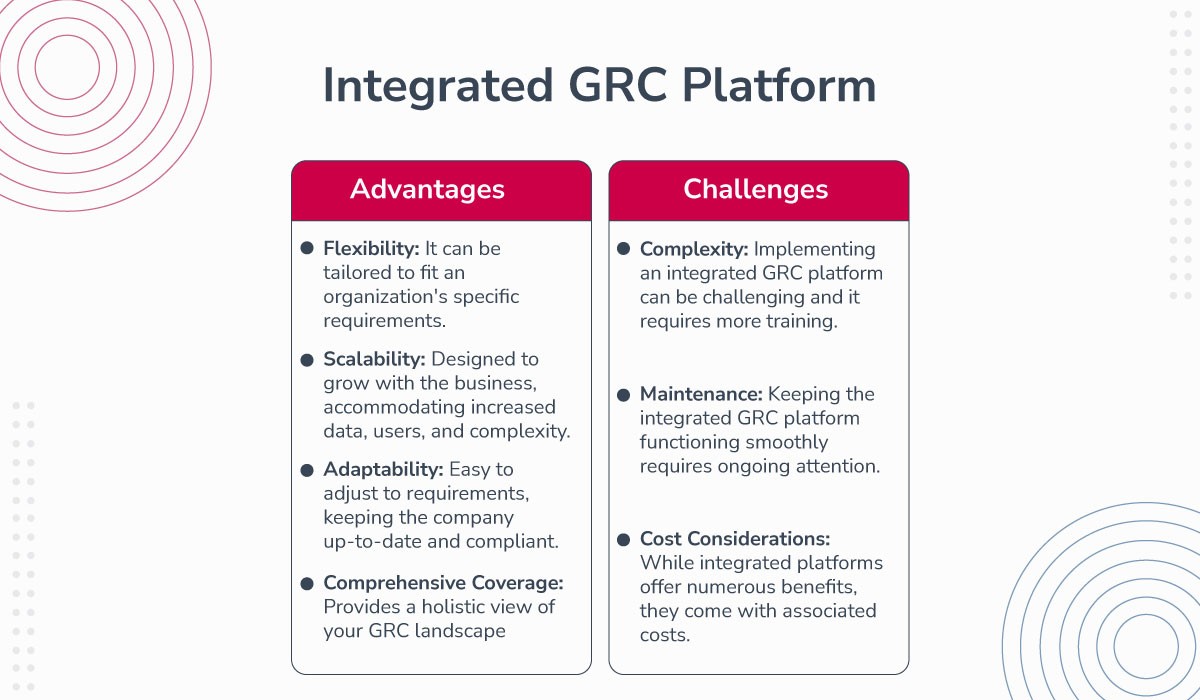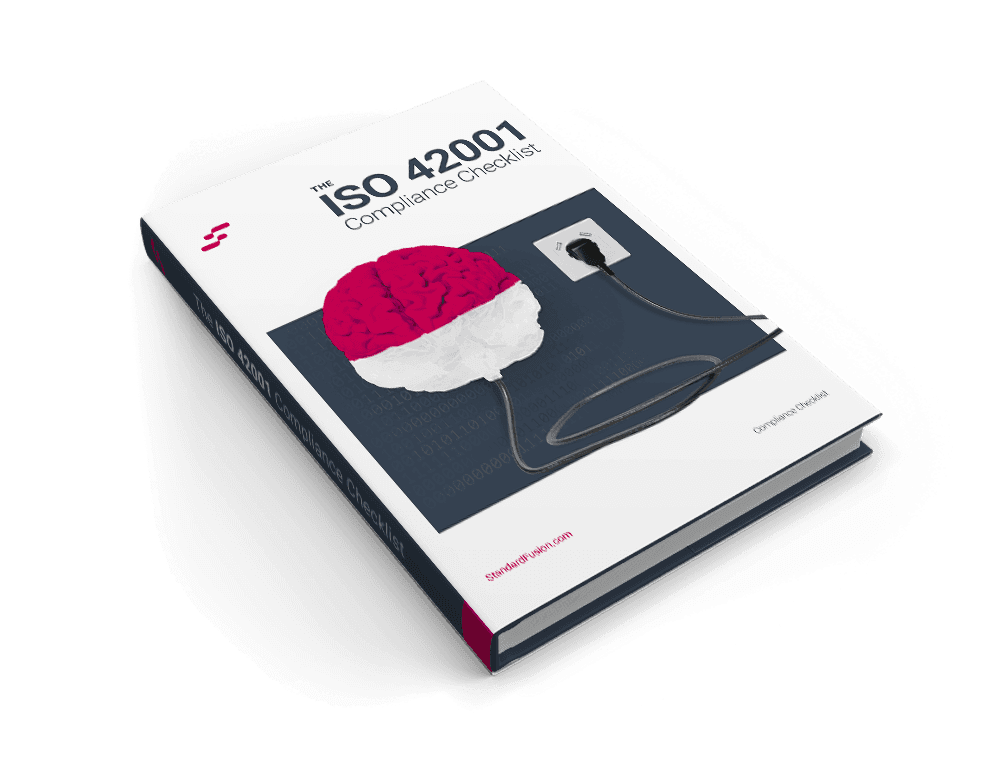Published on: Oct 17, 2023
| Updated: Mar 31, 2025
Out-of-the-Box and Integrated GRC Platforms: Options for Compliance Digital Transformation
This article analyzes the different ways of implementing Integrated or Out-of-the-Box GRC Platforms as part of digital transformation. It specifically focuses on the long-lasting value and adaptability of integrated systems.
Let's begin!
Understanding Out-of-the-Box GRC Platforms
Out-of-the-box GRC platforms offer predefined solutions designed for streamlined implementation. These platforms are characterized by their ready-to-use nature, aiming to simplify the adoption of GRC processes for organizations. Example: SA GRC platform that offers a ready-to-use SOC 2 Program.
Out-of-the-box GRC platforms are preconfigured software solutions that come with templates and workflows for managing governance, risk, and compliance activities. Moreover, they are designed to minimize the need for extensive customization and offer a more straightforward approach to implementing GRC practices.
Advantages:
Ease of Implementation: These platforms are preconfigured, reducing the complexity and time required for deployment. As a result, organizations can quickly adopt GRC processes without the need for extensive technical expertise.
Predefined Use Cases: Out-of-the-box platforms include templates and workflows for everyday GRC activities, such as policy management, risk assessment, and compliance tracking. This simplifies the adoption of best practices and ensures consistency.
Cost-Effectiveness for Smaller Organizations: These platforms can be more budget-friendly for smaller organizations that may not have the resources to develop custom GRC solutions. The predefined nature reduces the need for extensive development and maintenance costs.
Challenges:
Limited Customizability: As companies expand, their GRC programs and processes often become more intricate. Out-of-the-box solutions can become too rigid, limiting the ability to tailor processes to evolving needs.
Lack of Scalability: These platforms might struggle to handle increased data loads, intricate workflows, and a growing number of users. Performance issues can arise as the system tries to accommodate heightened demands.
Risk of Fragmented Systems and Data Silos: As various departments and functions adopt separate instances of the platform, data might become fragmented across different systems, leading to disconnected information and reduced visibility.
Out-of-the-box GRC platforms have challenges adapting to your organization's unique needs and growth, making the scalability issue the most important among growing organizations. Although, they can be a great implementation option for small GRC portfolios.

The Power of Integrated GRC Platforms
Integrated GRC platforms are helpful tools for organizations to manage their Governance, Risk, and Compliance efforts. In addition, they can improve the digital transformation process across departments by combining different aspects of GRC into one system. This makes it easier for companies to handle governance practices, manage risks, and follow regulations.
Integrated GRC platforms come with essential features that streamline compliance digital transformation. These features include tools for:
Risk assessment
Policy management
Compliance tracking
Audit management
Vendor management
Privacy management
Reporting
Having all these functions in one place reduces the need to juggle multiple systems and simplifies processes.
Why Integrations Matter
Integrations play a pivotal role in maximizing the effectiveness of a GRC platform. Without the ability to connect with existing tools in your tech stack, such as Jira, AWS, Okta, and more, the platform would necessitate manual work and constant switching between systems. This can complicate processes rather than simplify them.
The right integrations ensure that all compliance data, evidence, and controls are accessible in one centralized location. This not only saves time but also enhances peace of mind by reducing the risk of missing crucial information.
1. Centralized Access to Data
Integrating these tools means all compliance data, evidence, and controls are accessible from a single platform. This centralization eliminates the need to juggle between multiple systems, saving precious time and reducing the risk of errors.
2. Reduced Manual Effort
Without powerful integrations, manual processes would reign supreme. Imagine needing to pull reports, gather evidence, and manually upload them across disparate systems. Rather than spending time on repetitive tasks, integrations automate these processes, freeing up your team to focus on strategic initiatives.
3. Seamless Collaboration
Integrations foster better collaboration by allowing different teams to work within one system. By breaking down silos, teams can communicate more effectively, ensuring alignment across compliance activities.
4. Enhanced Automation
Automations are a key strength of any GRC platform. However, they are reliant on these integrations to function optimally. Integrations empower automations, handling tasks that would otherwise demand significant human intervention.
Incorporating seamless integrations with well-known tools like Jira, AWS, and Okta dramatically enhances GRC platform efficiency, making compliance management less about manual tedium and more about strategic oversight.
Advantages:
Flexibility: Integrated GRC platforms can be tailored to fit an organization's specific requirements. This adaptability ensures that the platform aligns with the company's unique processes and needs.
Scalability: As organizations grow, their GRC needs to evolve too. Integrated platforms are designed to grow with the business, accommodating increased data, users, and complexity.
Adaptability: Business environments are dynamic, and regulations can change. Integrated platforms can quickly adjust to new compliance requirements, keeping the company up-to-date and compliant.
Comprehensive Coverage: These platforms provide a holistic view of the organization's GRC landscape. This holistic approach helps identify interconnected risks, streamline processes, and reduce redundancy.
Challenges:
Complexity: Implementing an integrated GRC platform can be challenging. It involves integrating data from various departments, configuring the system, and training employees. This complexity can pose challenges during the setup phase.
Maintenance Requirements: Keeping the integrated GRC platform functioning smoothly requires ongoing attention. Regular updates, monitoring, and addressing technical issues are essential to ensure the platform's effectiveness.
Cost Considerations: While integrated platforms offer numerous benefits, they come with associated costs. Organizations need to factor in expenses related to software licenses, implementation, customization, training, and ongoing maintenance.

The Role of Continuous Controls Monitoring in a GRC Platform
Continuous Controls Monitoring (CCM) plays a pivotal role in a Governance, Risk, and Compliance (GRC) platform, fundamentally altering the way organizations manage their compliance frameworks. At its core, CCM shifts the paradigm from reactive to proactive, offering a seamless alternative to the traditional, labor-intensive process of manual controls testing.
Automating the Mundane
A key function of CCM is its ability to automate repetitive tasks that were once done manually. By consistently overseeing controls through the integration of advanced technology, CCM minimizes the dependency on sporadic manual checks. This automation not only saves time but greatly reduces the likelihood of human error, allowing organizations to focus their resources on more strategic initiatives.
Enhancing Workflow Efficiency
CCM enhances workflow efficiency by integrating with existing systems to automate the collection of crucial data. APIs allow for scheduled data pulls, contributing to real-time insight into risk management and compliance status. This streamlined process enables organizations to operate more effectively, doing more with fewer resources.
Balancing Automation with Human Expertise
While CCM significantly contributes to efficiency, it's essential that it works in tandem with human insight. Relying solely on automation can lead to oversight and can diminish the strategic value provided by human contribution. Human expertise remains vital to interpret data, make informed decisions, and adapt compliance strategies as regulations evolve.
Cost and Time Savings
By drastically reducing the man-hours required for compliance tasks, CCM offers substantial cost and time savings. Automated controls and regular monitoring render manual intervention less frequent, thus allocating financial resources and employee efforts to areas where they are most needed.
In summary, Continuous Controls Monitoring elevates the functionality of GRC platforms by enabling constant vigilance over controls, enhancing efficiency, and preserving the essential balance between automation and human insight. It’s a game-changer in the compliance landscape, providing organizations with the agility and intelligence necessary to manage risk effectively.
How Workflow Automation Benefits a GRC Platform
Streamlining Processes and Saving Time
One of the most significant advantages of using workflow automation in a GRC (Governance, Risk, and Compliance) platform is the ability to streamline various processes, thereby saving precious time. By automating tasks such as evidence collection and real-time risk reporting, organizations can efficiently manage their compliance workloads. This automation frees up valuable time for employees to focus on more strategic activities rather than getting bogged down in repetitive, time-consuming duties.
Reducing Errors
Automated systems help reduce human error. By setting up APIs to collect data from various systems automatically, GRC platforms eliminate the manual entry mistakes that can complicate compliance management. This ensures accurate data collection, which is essential for maintaining compliance and managing risk effectively.
Cost Efficiency
The efficiencies gained through automation also translate into significant cost savings. With routine tasks handled automatically, fewer resources are needed to manage these activities. This allows organizations to "do more with less" by reallocating human resources to areas that necessitate critical thinking and strategic input, ultimately boosting overall productivity.
Continuous Monitoring and Control
Another benefit is the implementation of continuous controls monitoring (CCM). Automation facilitates ongoing or high-frequency monitoring of controls, ensuring that they are consistently effective in mitigating various risks. This proactive approach gives organizations the ability to quickly identify and address issues, maintaining robust risk management and ensuring compliance.
Enhancing Human Expertise
While automation is a powerful tool, it is most effective when combined with human expertise. The strategic input of employees is essential for building a robust compliance program. Rather than putting compliance efforts on autopilot, automation should serve to enhance existing workflows, making them more efficient and allowing human talent to focus on improving and innovating these processes.
In summary, workflow automation in a GRC platform provides time savings, reduces errors, is cost-effective, ensures constant monitoring, and enhances the value of human expertise. This allows organizations to maintain a dynamic and proactive compliance strategy.
The Long-Term Benefits of Integrated GRC Platforms
Integrated GRC (Governance, Risk, and Compliance) platforms offer a range of enduring benefits that streamline operations and optimize resource utilization over time. These advantages encompass:
Enhanced Efficiency: Integrated platforms streamline processes by consolidating data, workflows, and tools. This reduces redundant tasks and minimizes manual efforts, increasing operational efficiency.
Scalability for Future Growth: These platforms are designed to accommodate expanding business needs. As your organization grows, the integrated system can easily adapt to handle increased data volumes and complex operations.
Comprehensive Visibility and Control: Integrated GRC platforms provide a unified view of all relevant data and processes. This holistic perspective allows for better tracking, analysis, and decision-making across departments.
Flexibility and Customizability: These platforms are tailored to match the unique requirements of your organization. This ensures that the platform aligns with your existing processes and can be adjusted as needs evolve.
Improved Decision-Making: With consolidated data and analytics, integrated platforms enable informed decision-making. Real-time insights foster a proactive approach to risk management and compliance.
Investment Returns over Time: While there's an initial investment, the efficiency gains and operational improvements lead to long-term cost savings and enhanced returns on the investment.
Seamless Integration with Other Systems: Integrated GRC platforms can connect smoothly with other critical business systems, promoting data sharing and optimizing cross-functional processes.
Effective Adaptability to Regulatory Changes: Regulations are constantly evolving. Integrated platforms can be updated to incorporate new requirements swiftly, ensuring continued compliance without major disruptions.
Future-proofing Your GRC: These platforms are designed to stay relevant over time. Their adaptability ensures they remain effective in addressing changing business needs and regulatory landscapes.
Evaluating Your GRC Needs: Key Considerations
To effectively evaluate your compliance digital transformation program and select the right GRC platform, consider the following factors:
Initial Questions to Ask:
What Problems Do You Need to Solve? Identify the specific issues your organization faces that a GRC platform could address.
What Do Your Stakeholders Need? Understand the requirements and expectations of all stakeholders to ensure the GRC platform aligns with their needs.
What Resources Do You Have for Implementation? Assess the resources available, including time, personnel, and technology, to implement the platform effectively.
What’s Your Budget? Determine your financial constraints to ensure the chosen solution is sustainable in the long term.
Evaluating Operational Needs:
1) Current GRC Needs:
Size of Your Organization: Take into account the size of your company, as larger organizations have more complex GRC needs.
Industry-specific Requirements: Different industries have unique regulations and standards. Understand how your industry's requirements impact your GRC strategy.
Complexity of Business Processes: Analyze the intricacy of your business processes, as more complex operations demand a more robust GRC approach.
Personnel Skills: Evaluate if employees might need upskilling and training to manage digitalized processes.
2) Future GRC Needs:
Growth Plans: Consider your organization's growth projections. As your company expands, your GRC needs may evolve to manage new challenges.
Business Diversification: If you're entering new markets or sectors, assess how these changes impact your GRC requirements.
Regulatory Landscape: Be aware of changing regulations and compliance standards. Your GRC strategy should adapt to stay aligned with these shifts.
3) Resource Evaluation:
Budget: Understand the financial resources available for your GRC efforts. Balancing your budget with GRC priorities is crucial.
IT Capabilities: Assess your IT infrastructure's capabilities to support GRC processes, including data security and system integration.
Human Resources: Consider the availability of skilled personnel to manage and oversee your GRC initiatives effectively.
4) Essential Platform Features:
When choosing a GRC platform, it's crucial to identify a solution that aligns with your organization's unique needs. The platform should:
Streamline Compliance: Ensure it automates processes to reduce the headache of manual tasks.
Offer Flexibility: Avoid systems that are inflexible or tied to legacy solutions, which can hinder your ability to adapt.
Comprehensive Features: The platform should encompass all necessary features that support your compliance goals, tailored to your industry and scalability requirements.
Ultimately, the most important consideration is finding a platform that not only meets your current and future needs but also enhances your team's ability to maintain compliance efficiently. By focusing on these elements, you can select a GRC platform that integrates smoothly into your existing framework while preparing you for growth and change.
Integrated GRC or Out-of-the-box: Which one Should You Choose?
Compliance digital transformation is a strategic initiative that can help organizations improve compliance performance, reduce risks, and enhance customer trust. However, choosing the right GRC platform to support this initiative is not trivial.
Organizations must consider their current and future GRC needs, goals, and challenges, and evaluate the pros and cons of different GRC platforms.
Out-of-the-box GRC platforms can offer a quick and easy way to implement GRC processes, especially for smaller organizations with limited resources and simple GRC requirements.
They can provide predefined solutions that can reduce the complexity and cost of deployment and maintenance. However, they can also pose limitations regarding customizability, scalability, and integration, hindering the organization's ability to adapt to changing regulations, business needs, and customer expectations.
Integrated GRC platforms can offer a more flexible and adaptable way to implement GRC processes, especially for larger organizations with complex and dynamic GRC requirements.
They can provide a holistic and coordinated view of the organization's GRC performance, integrating with existing systems and data sources. Integrated GRC platforms can also leverage digital technologies such as data analytics, automation, artificial intelligence, and cloud computing to enhance the efficiency, effectiveness, and agility of compliance processes. However, deploying and maintaining can also require more technical expertise and investment.
Ultimately, the choice of the GRC platform depends on the organization's specific situation and preferences. There is no one-size-fits-all solution for compliance digital transformation. Organizations should weigh the benefits and drawbacks of each option carefully and select the one that best suits their needs and goals.
Key Takeaways
Out-of-the-box GRC platforms offer quick implementation, predefined use cases, and cost-effectiveness for smaller organizations.
Challenges of out-of-the-box platforms include limited customizability, lack of scalability, and risk of data fragmentation.
Integrated GRC platforms offer flexibility, scalability, adaptability, and comprehensive coverage of governance, risk, and compliance aspects.
Challenges of integrated platforms include implementation complexity, ongoing maintenance needs, and higher costs.
Long-term benefits of integrated GRC platforms include enhanced efficiency, future scalability, comprehensive visibility, improved decision-making, and adaptability to regulatory changes.
To choose the right platform, organizations must consider current and future GRC needs, including size, industry-specific requirements, growth plans, and available resources.







